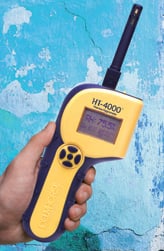 Doing water damage restoration work right takes a lot of time and effort. If a restoration job isn't done with absolute thoroughness, it can result in callbacks and a loss of reputation. In a recent post, we talked about how you can use moisture meters for restoration jobs to avoid such issues.
Doing water damage restoration work right takes a lot of time and effort. If a restoration job isn't done with absolute thoroughness, it can result in callbacks and a loss of reputation. In a recent post, we talked about how you can use moisture meters for restoration jobs to avoid such issues.
Today, we’ll talk a bit about how you can use relative humidity sensors in restoration work to help you track down leaks and verify that there is no more water seeping into a structure.
How Relative Humidity Impacts Restoration Work
The ambient moisture in the air can have a significant influence on your water damage restoration efforts. Basically, the more humidity is present, the longer it will take for building materials to finish drying out.
High humidity can also be an indication of a persistent moisture intrusion source within a structure.
Relative humidity (RH) sensors allow you to track ambient humidity in a structure. With information on the relative humidity within a given room, you can focus your restoration efforts where they’ll have the greatest effect.
About Thermo-Hygrometer RH Sensors
There are many different kinds of relative humidity sensors on the market. One of the most common types of RH sensor is the thermo-hygrometer, a device that can monitor both temperature and RH over a given area.
Thermo-hygrometers are especially useful for monitoring RH because the temperature of the room can impact RH readings. By monitoring both temperature and RH values, you can adjust your reading values to account for temperature.
Using RH Sensors on the Job
When using a thermo-hygrometer on a restoration job, it’s important to take several readings in each room that you’re working in. This not only helps you track changes in RH over time, it can help you overcome the issue of sensor tolerance (the built-in margin of error present in any RH meter) by letting you average a large number of readings.
In larger rooms, be sure to take RH readings in different areas of the room. The RH value of a large room may be different from one end of the room to the other. This can also help you narrow down the search area for moisture-compromised building materials.
Record your RH values for the jobsite before, during, and after the completion of your restoration efforts. Doing so helps establish the necessity of your work, and how effectively you addressed the excess moisture in the structure over time.
If you notice that the RH value in a given room is still high a day or two after moisture extraction is “complete,” then there may be a persistent source of moisture or moisture-compromised materials still present in the structure. To identify the specific materials that have been compromised, the use of a restoration moisture meter is recommended.
To make sure that your RH sensors remain as accurate as possible, keep them in a sealed case when you’re not actively using them. Leaving RH sensors in extremely humid conditions for too long can cause damage to the sensor, reducing accuracy.
These are just a few tips for using RH sensors for restoration work. By using RH sensors the right way, you can increase the traceability and effectiveness of your restoration work.

Comments